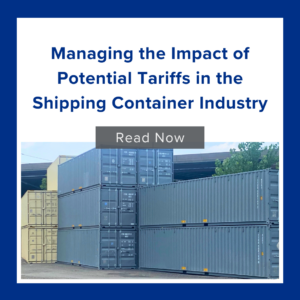Managing the Impact of Potential Tariffs in the Shipping Container Industry
As potential tariff policies loom, their ripple effects are anticipated to significantly impact shipping container prices. With proposed tariffs on Chinese goods and imports from Mexico and Canada, the container market is bracing for fluctuations driven by shifts in global trade dynamics.
Rising Demand and Preemptive Stockpiling
One of the most immediate impacts of the tariff threats has been a surge in demand for shipping containers. Importers, seeking to avoid the higher costs that would accompany the tariffs, are front-loading shipments. This rush to beat tariff deadlines has strained the availability of shipping containers, causing prices to plummet.
Moreover, labor disputes at major U.S. ports have further fueled urgency among shippers. This combination of factors has created a volatile market for container procurement, making prices unpredictable due to limited supply and heightened demand.
Factory Costs and Tariff Implications
The production cost of new, one-trip containers—often sourced from China—is another key factor influencing container prices. If tariffs are imposed on Chinese goods, the cost of manufacturing these containers may rise, as raw materials and components become more expensive. Additionally, the tariffs could directly increase the cost of importing finished containers into the U.S., driving up prices for customers in the near future.
Price Variability in Used Containers
While new containers face direct cost increases from tariffs, the used container market may experience a different kind of volatility. As businesses scramble to secure containers, used containers are becoming an attractive alternative, leading to price increases even in this segment. However, availability in the used market is limited, exacerbating the pricing pressures.
Broader Industry Perspectives
Industry leaders like Hapag-Lloyd CEO Rolf Habben Jansen have pointed out that global trade’s resilience often mitigates the long-term impacts of tariffs. However, in the short term, container buyers, especially smaller businesses, may face challenges in absorbing the costs. The uncertainty of container prices could ultimately be passed along the supply chain, affecting product pricing and availability for consumers.
Controlling Costs in an Uncertain Market
For businesses dependent on shipping containers, several strategies can help mitigate these market fluctuations:
- Leverage Existing Inventory: Companies with access to in-house or leased containers may be able to sidestep some of the volatility.
- Diversify Suppliers: Exploring alternative sources for new and used containers outside traditional markets like China may help reduce dependency on tariff-affected products.
- Optimize Container Utilization: Efficient packing and strategic planning can minimize the number of containers required, thereby reducing overall costs.
Conclusion
The potential tariffs underscore the importance of agility and foresight in the shipping industry. As container prices remain susceptible to policy changes and market pressures, stakeholders must stay vigilant and adapt their procurement and supply chain strategies to navigate this evolving landscape. At Interport, our strong supplier relationships and extensive inventory of both new and used containers position us to support businesses in mitigating these challenges. Interport’s ability to maintain inventory and price containers competitively ensures that customers can access the equipment they need without facing undue delays or cost surges.
Sources:
FreightWaves: “Tariff Threats Roil North American Container Marketplace“
WorldCargo News: “Hapag-Lloyd CEO: Trump Tariffs Could Pressure Some Sectors But Won’t Derail Global Trade“
Additional Industry Insights from Market Trends and Analysis
